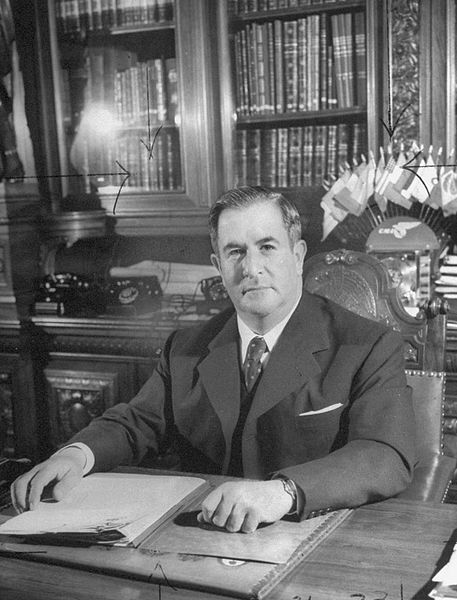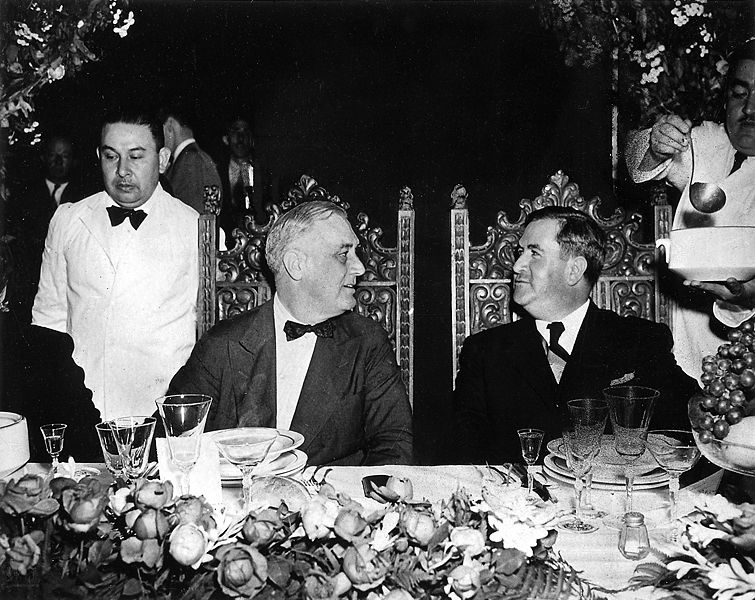<Back to Index>
- Mathematician Simon Antoine Jean L'Huilier, 1750
- Poet Carl Friedrich Georg Spitteler, 1845
- President of Mexico Manuel Ávila Camacho, 1897
PAGE SPONSOR


Manuel Ávila Camacho (24 April 1897 – 13 October 1955) served as the President of Mexico from 1940 to 1946.
Manuel Ávila was born in the city of Teziutlán, a small town in Puebla, to middle class parents, Manuel Ávila Castillo and Eufrosina Camacho Bello. He had several siblings, among them sister María Jovita Ávila Camacho and several brothers. Two of his brothers, Maximino Ávila and Rafael Ávila Camacho both served as governors of Puebla. Ávila did not receive a university degree, although he studied at the National Preparatory School. He joined the army in 1914 as a 2nd lieutenant and reached the status of Colonel by 1920 and, in the same year, served as the Chief of Staff of the state of Michoacán under Lázaro Cárdenas, and became his close friend. In 1929, he fought under general Cárdenas against the Escobar Rebellion and, that same year, achieved the rank of Brigadier General. He was married to Soledad Orozco García, who was born in Zapopan, Jalisco. Soledad Orozco was one of the Orozcos of the State of Jalisco. She was born in 1904 and died in 1996.
After
his military service, Ávila entered the public arena in
1933 – 1934 as the Official Mayor of the Secretariat of National
Defense, and became Secretary of National Defense in 1937. Two years
later, he
was elected president of Mexico, after being appointed to represent his
party. Ávila won a controversial presidential election over
right wing candidate Juan Andreu Almazan. The day of the election was marked by violence, and the electoral process was likely tainted with electoral fraud. During his term, Ávila faced the difficulty of World War II. After two of Mexico's ships carrying oil were destroyed by German submarines in the Gulf of Mexico, Ávila declared war against the Axis powers on 22 May 1942. 15,000 Mexican soldiers fought in the war, on a variety of fronts, including an Airborne squadron, the 201st, to fight the Japanese in the Pacific. Furthermore, starting a period of friendship with the United States, Ávila cooperated in the war effort, providing his northern neighbour with 300,000 workers under the Bracero Program to replace some of the Americans who had left to fight in the war. Mexico also resumed diplomatic relations with the United Kingdom and Soviet Union, which had been broken off during the presidency of his predecessor. In 1944, Mexico signed the United Nations Charter and the following year became the headquarters of the Interamerican Conference about War and Peace. Ávila
was a professed Catholic, which was a change from his predecessors in
the first half of the twentieth century who had been strongly anticlerical. His open profession of faith was politically dangerous as it risked the ire of Mexican anticlericals. Domestically,
Ávila protected the working class, creating social security in
1943 and working to reduce illiteracy. He continued land reform and
declared a rent freeze to benefit low income citizens. He also promoted
election reform, creating new requirements that made it impossible for communists to run. He was also responsible, on 18 January 1946, for renaming what had been the Party of the Mexican Revolution (PRM) to the name it carries today, the Institutional Revolutionary Party (PRI). When his term ended in 1946, Ávila retired to work on his farm. He died on 13 October 1955.